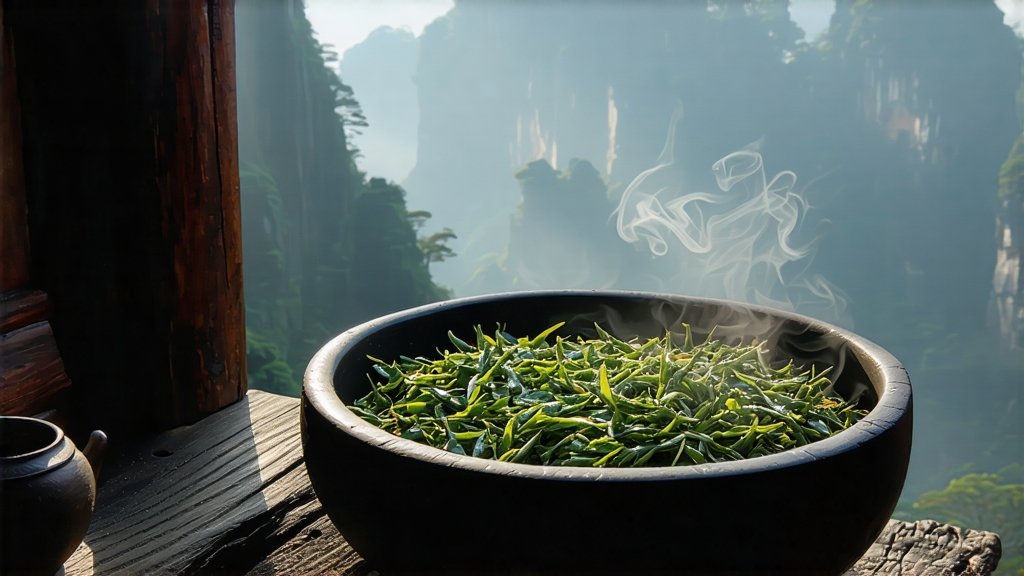
If every tea has a passport, Lapsang Souchong’s is stamped with the soot of pine needles and the salt spray of the Min River. Born in the precipitous Wuyi Mountains of northern Fujian, this rugged black tea was the first to leave China in bulk, sail around the Cape of Good Hope, and scent the drawing rooms of 17th-century London. Today it is celebrated as much for its campfire aroma as for the sweet, longan-like liquor that surprises first-time drinkers who expect only smoke. Understanding Lapsang Souchong is therefore a journey through Chinese ingenuity, global trade, and the alchemy of leaf, fire, and time.
Historical footprints
The name itself is a linguistic relic. “Souchong” refers to the fourth and fifth leaves down the stem—once considered too coarse for green-tea tribute but perfect for the slow withering and heavy oxidation that black tea demands. “Lapsang” is a corruption of the Minnan phrase la (pine) and xun (smoke), indicating the distinctive drying method. Local legend attributes the birth of smoking to an emergency: Qing-era soldiers requisitioned a village’s drying sheds, forcing farmers to rush their tea over open pinewood fires so it would keep until market day. Whatever the truth, by 1604 Dutch traders were listing “Bohea” (Wuyi) smoked leaf among the most valuable cargoes in Batavia. When Catherine of Braganza brought her tea habit to the British court in 1662, Lapsang Souchong was the fragrant emblem of exotic luxury, priced higher than silver.
Two families under one name
Modern markets use “Lapsang Souchong” loosely, but connoisseurs distinguish two distinct styles. Traditional Zheng Shan Xiao Zhong is produced inside the 600 km² core of the Wuyi Nature Reserve, using only Xingcun Xiaozhong cultivar, pine-wood fuel from Pinus massoniana, and the three-century-old smoke sheds built from volcanic tuff. Its leaf is strip-shaped, jet-black with golden tips, and the cup balances wisps of pine with notes of dried longan, cocoa, and a cooling camphor finish. Outside the reserve, particularly in the counties of Wuyishan City and beyond, Waishan Xiaozhong is made from larger-leaf bushes, often dried with electric heaters and scented with added essences; the result is darker, more pungent, and sometimes bitter. Knowing the provenance is therefore the first step toward an authentic experience.
Crafting smoke without haste
The production calendar begins in late April, after the first flush green teas have been harvested, allowing the bushes to accumulate more sugars. Pickers take one bud with two or three mature leaves, aiming for a slight purple tinge that signals high anthocyanin content. The leaves are withered on bamboo trays suspended in the second story of the smoke sheds, where gentle heat (28–30 °C) from ground-level pinewood fires rises through slatted floors. Over the next eight to ten hours the leaf loses 60 % of its moisture while absorbing resinous volatiles—guaiacol, syringol, and creosol—that later translate into the tea’s signature aroma.
Once supple, the leaves are rolled for 45 minutes in bamboo-ribbed machines that twist the cell walls without breaking them, initiating enzymatic oxidation. The oxidization stage is brief—only two to three hours—because the goal is a coppery mahogany rather than the deep chocolate of Assam. A second, hotter firing (80 °C) follows, again over pine embers, locking in color and stopping oxidation. Finally the tea is given a “cold smoke”: the fires are damped to smoulder below 50 °C, and the leaf is spread on woven rattan shelves for six to eight hours, slowly drying to 5 % moisture while the smoke polymers condense on the leaf surface. The entire process takes twenty-four hours, a marathon that demands the craftsman stay awake to adjust draughts, shuffle trays, and sniff for the moment when resin sweetens into fruit.
Terroir in a cup
The Wuyi Nature Reserve is a UNESCO biosphere where morning fog insulates the narrow gorges, softening sunlight and forcing the tea bush to produce more L-theanine. The granitic soils are poor in nitrogen but rich in potassium and manganese, minerals that enhance polyphenol